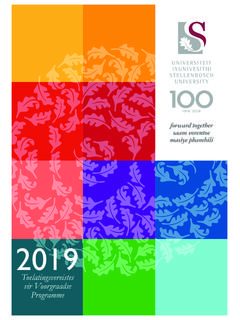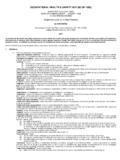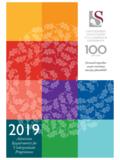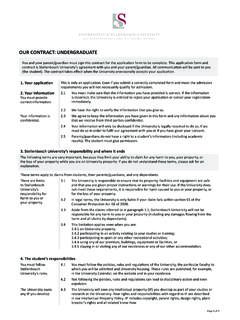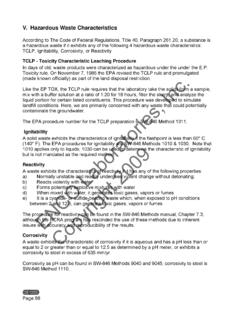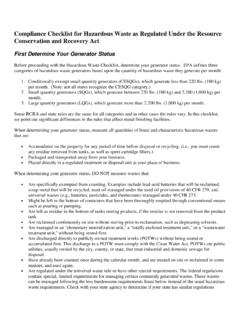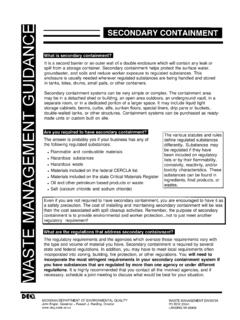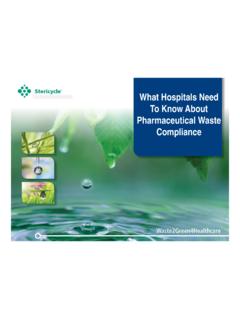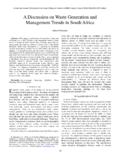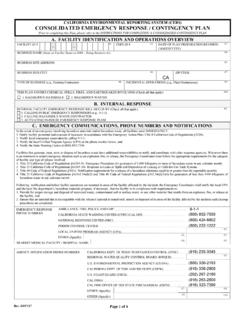Transcription of OPERATIONAL MANUAL 2010 PROPERTY SERVICES …
1 1 hazardous waste MANAGEMENT OPERATIONAL MANUAL 2010 PROPERTY SERVICES contact PERSON: MEG PITTAWAY E-MAIL: INDEX: CHAPTER ONE: INTRODUCTION AND GENERAL INFORMATION CHAPTER TWO: waste MINIMISATION CHATER THREE: RECORD KEEPING CHAPTER FOUR: BIOLOGICAL AND MEDICAL waste MANAGEMENT CONTAINERS AND STORAGE LABELING COLLECTION PROCEDURES CHAPTER FIVE: CHEMICAL waste COLLECTION CONTAINERS AND STORAGE LABELING COLLECTION PROCEDURES SPILL PREVENTION AND CLEAN-UP CHAPTER SIX: RADIO ACTIVE waste COLLECTION CHAPTER SEVEN: ASBESTOS waste COLLECTION CHAPTER EIGHT: E- waste COLLECTION CHAPTER NINE: MERCURY (BATTERIES AND FLOURESCENT BULBS) APPENDIX A: LIST OF INCOMPATIBLE CHEMICALS APPENDIX B: LIST OF POTENTIALLY EXPLOSIVE COMPOUNDS ANNEXURE 1: LIST OF APPLICABLE LEGISLATION AND REGULATIONS GOVERNING hazardous waste REMOVAL ANNEXURE 2: ANNEXURE 2: waste COLLECTION FORM ANNEXURE 3: COLLECTION SHEET 3 CHAPTER ONE: INTRODUCTION AND GENERAL INFORMATION Our vision at Facilities Management on the Stellenbosch University campus is to ensure a functional and safe infrastructure and facilities service that will have a significant contribution to a positive student and workplace experience.
2 Stellenbosch University recognizes its responsibilities to reduce and minimize waste and impacts on resources and the environment through following the correct procedures and practices. Various legislative changes have taken place since 2000 due to global agreement on the impacts of waste on human and environmental health. Parliament adopted the white paper on Integrated Pollution and waste management for South Africa in 2000 as the national policy on pollution and waste management. DEAT is currently introducing draft legislation related to holistic, integrated waste management. These statutory reforms and a declaration at Polokwane in 2000, adopted by DEAT with the targets that require the country to conform to global practice, are aimed at minimizing environmental impacts and waste landfill to achieve a long term zero- waste goal.
3 The overall aim of SU s waste management strategy is in line with that of National waste Management Strategy, inter alia: waste must be managed through various processes that will ensure a safe, healthy and a sustainable environment to ensure the rights of individuals are protected as enshrined in of the Constitution. The right requires that all stakeholders must accept co-responsibility for minimizing waste impacts optimally, to ensure environmental sustainability. hazardous waste is waste that has the potential, even in low concentrations, to have a significant adverse effect on public health and the environment because of its inherent toxicological, chemical and physical characteristics. hazardous waste requires stringent control and management, to prevent harm or damage and hence liabilities.
4 It may only be disposed of on a hazardous waste landfill. To reduce generation of waste and the environmental impacts of all forms of waste , so that the socio-economic development of South Africa, the health of the people and the quality of the environment resources are no longer affected by the effects of waste . (NWMSI Report, 2004, ) 4 Since the Precautionary Principle is applied, a waste must always be regarded as hazardous where there is any doubt about the potential danger of the waste stream to man or the environment. A hazardous waste is defined as An inorganic or organic element or compound that, because of its toxicological, physical, chemical or persistency properties , may exercise detrimental acute or chronic impacts on human health and the environment.
5 It can be generated from a wide range of commercial, industrial, agricultural and domestic activities and may take the form of liquid, sludge or solid. These characteristics contribute not only to degree of hazard, but are also of great importance in the ultimate choice of a safe and environmentally acceptable method of disposal. Further to this, a hazardous waste can be defined as a waste that directly or indirectly represents a threat to human health or the environment by introducing one or more of the following risks: Explosion or fire Infections, pathogens, parasites, or their vectors Chemical instability, reactions or corrosion Acute or chronic toxicity Cancer, mutations or birth defects Toxicity, or damage to the ecosystems or natural resources Accumulation in biological food chains, persistence in the environment, or multiple effects to the extent that it requires special attention and cannot be released into the environment or be added to sewage or be stored in a situation which is either open to air or from which aqueous leachate could emanate.
6 To the extent that it requires special attention and cannot be released into the environment or be added to the sewage or be stored in a situation which is either open to the air or from which aqueous leachate could emanate. Currently we have identified the following general hazardous waste streams that are been generated at Stellenbosch University: Biological waste Medical waste Chemical waste Radioactive waste Asbestos waste Mercury waste (batteries and fluorescent bulbs) 5 PROPERTY SERVICES , through its Integrated waste Management program, provides comprehensive waste SERVICES to Stellenbosch University. These SERVICES include hazardous waste management, waste stream identification, collection, and disposal. PROPERTY SERVICES coordinates with off-site waste management contractors for pick-up and disposal of hazardous waste .
7 All generators of hazardous waste need to have a clear understanding of the legislation and regulations that govern hazardous waste , the potential penalties and all environment and safety risks. PROPERTY SERVICES is currently managing the removal of the waste but the responsibility of the waste remains with the primary generators. This responsibility lays with the department head. The responsibility of this waste starts with the correct labeling and storage of chemicals to the final accumulation of waste for removal. This needs to be managed within the regulations and codes of practice as stipulated in various legislature which governs these processes. Anybody not adhering to the standard practices as set out below will not have their waste collected.
8 This puts the University at a huge risk. It is essential that these practices are understood at all levels of operation and not left to the lab assistants. Training of staff in correct procedures will be done by selected consultants in consultation with PROPERTY SERVICES and Protection SERVICES . To be sure that any waste generated meets all applicable university and government legislation, please contact PROPERTY SERVICES before work with any hazardous materials begins. Direct your questions and concerns to PROPERTY SERVICES Tel: 021 808 3776, Fax: 021 808 4669, or E-mail: CHAPTER TWO: waste MINIMISATION SU need to minimize and manage waste minimization in a sustainable, effective, equitable and efficient manner that will minimize environmental and economic impacts as far as possible.
9 All generators of hazardous waste are bound by the practices as listed below as to facilitate and encourage effective waste minimization as per the NWMS waste Management hierarchy to: 6 Encourage waste avoidance that will reduce waste generation at source Re-use waste in its original form as far as possible. Investigate the possibility of suppliers taking back excess chemicals for re-use. In 2001 some 28 countries had "take-back" mandates for packaging, another 16 had battery recovery laws, and 12 planned to implement electronics recycling laws (Business for Social Responsibility, 2001). The extension of producer responsibility to end-of-life products has been enacted or is under serious consideration in the European Union, Japan, Taiwan, Korea, Brazil, Peru, and Canada.
10 The range of products and waste streams targeted under these emerging policies includes packaging, paper goods, consumer electronics, office machinery, cars, tyres, furniture, electrical appliances, buildings and construction materials, batteries, and household hazardous waste . Promote the separation of waste into different streams at source prior to collection for recovery and recycling purposes. Implement waste diversion away from landfill by processing or treatment of hazardous waste in an economical and environmentally sustainable way that may exist for the neutralization of various chemicals that renders them environmentally safe. the neutralization of ethidium bromide using a charcoal filter. SU is currently investigating several initiatives for the minimization of hazardous waste by looking at a central cyber store to processes that may render waste environmentally safe.
